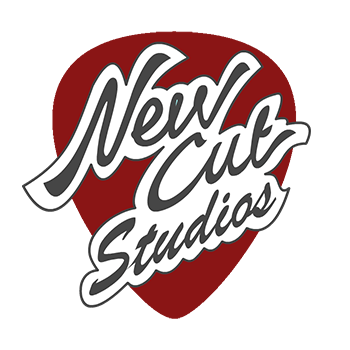Airline Jet Set…
… resonating resin.
Whilst researching the The White Stripes’
Elephant album for a blog about 8-track recording, I got somewhat distracted looking into the rig Jack White was using at the time. In the blog I talk about the arch-top Kay guitar that he used to record 'Seven Nation Army', but the guitar he used in the hypnotic video for the same song — and which was used to record most of
Elephant — was his red, two pickup, Res-O-Glas Airline made by the Valco company*. The visual impact of that promo film on the guitar world was such that retro revivalists Eastwood brought out a copy of that instrument. At one time known as the Jetsons model, this Res-O-Glas Airline later came to be known as the JB Hutto guitar — for the bluesman who was the earliest name player to pick one up and be seen to do so on record covers. Coincidentally, while I was researching Airline Jetsons for the
Elephant blog, I had one sat in my lap.
The Airline Near My Fingers
I mean… yes I chose to look over this repro while researching vintage Airlines… but it’s still seems like synchronicity that I have an Airline Jetson for repair right now, just when I was looking into the guitars Jack White played on Elephant. This guitar is the white 2 pup Jetsons/Hutto that belongs to Kurt from Bristol Psych-Rock wizards Raptor and it needs a fret mill amongst other things. Having made basic adjustments to truss rod, bridge height and saddle length I think it’s going to play nicely, once I sort the frets out and fine tune the set-up**. Of course the striking thing about this guitar is the way it looks. It’s the styling that first catches the eye. The body shape is all angular lines and triangular horns complimented by a flaring, asymmetric head stock. It is Populuxe ornament applied to the guitar and when Valco introduced the style in 1964 it looked like nothing else with strings on. It was spikey, space-age and state-of-the-art. Now Gibson may have been the first to start making guitars with pointy protuberances in 1958 — but even more than the shape, it was the Jetson’s construction that was cutting edge.
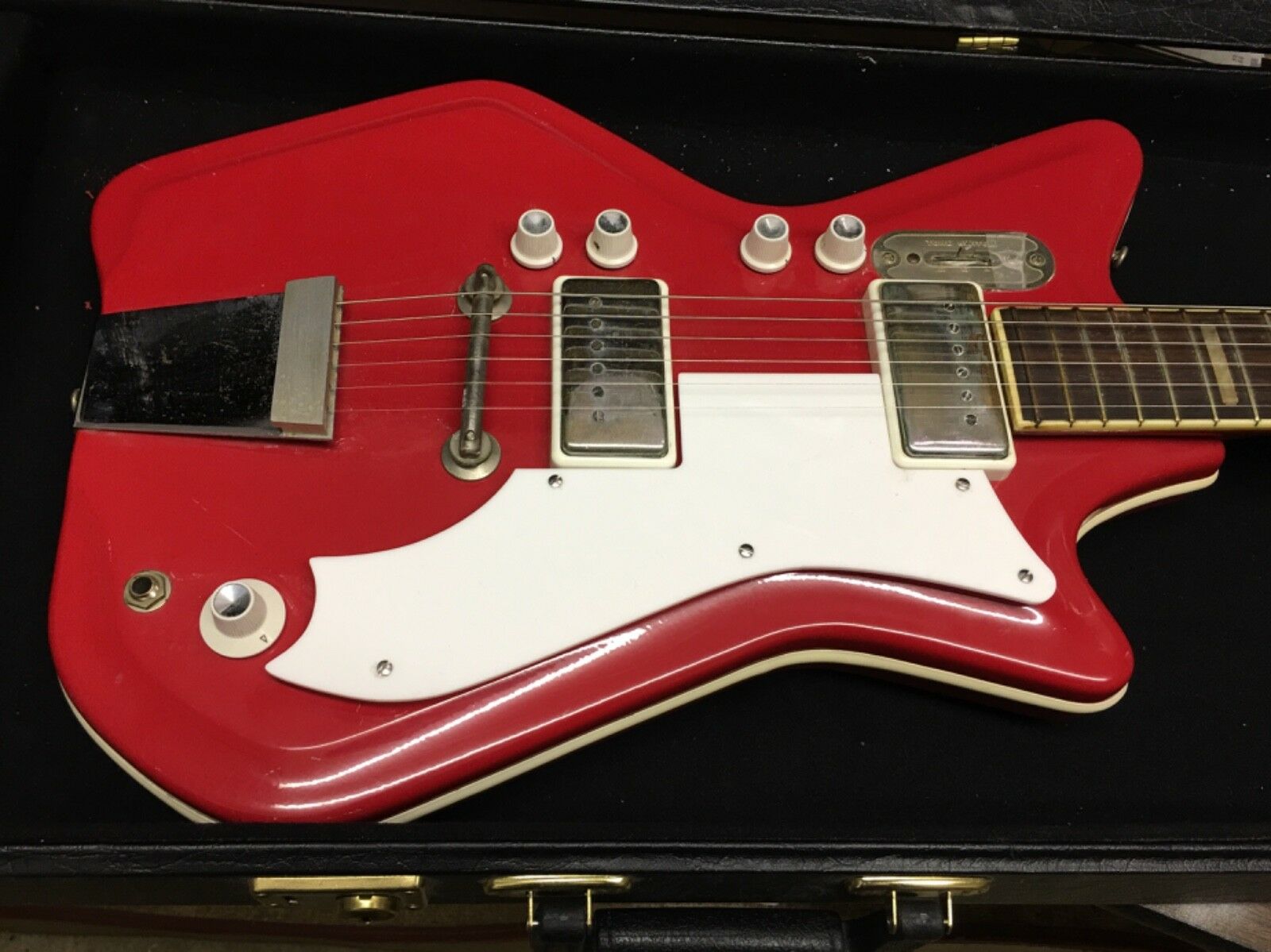
Dupont’s early experiments in resin-set glass fibres in 1936 produced a material that was strong, stable and extremely versatile. By the 1960s woven glass fibre sheets, sculpted and set in polymer resin, was the new material for a host of products: from boat hulls to car bodies to furniture. But it looks like Valco were the first company to make guitars from it, going into production in 1961 — five years earlier than Ovation’s bowl-back acoustic designs. I should also mention the British Fenton-Weil Fibratone guitar which can possibly be dated as early as 1964, the same year the Jetsons/Hutto model debuted. Actually Valco’s earliest experiments with stringed instruments made of ‘fiberglas’ (as they called it), started in the 1950s with a small bodied upright bass design which they sold to Ampeg. The earliest Valco Res-O-Glas bodied guitars were more orthodox in shape than the Jetson. Supro Belmonts, Martiniques and Dual Tones; National Town & Country models: all these reproduced more traditional body shapes already common to National & Supro Val-Trol wooden guitars. The National R-O-G models that came to be known as the ‘Map’ guitars were much curvier than the Jetson, but no less inventive in their shapes. These Val-Pro Westwood, Newport and Glenwood models were increasingly unorthodox with their Streamline Moderne shapes and Art Deco flourishes. I’ll talk about the Eastwood take on the Map guitars a little later.
Valco of course are most famous for their Supro and National brands and it was under these names that Res-O-Glas instruments first appeared. The R-O-G Airlines were made by Valco for Montgomery Ward (an American department store/catalogue brand), who also commissioned their Airline branded guitars & amps from Harmony, Kay & Danelectro, just as Sears did under the Silvertone banner***. In recent years Airline, National and Supro guitars & amps have all been revived with reissues by modern companies. Back in the ‘50s & ‘60s, Supros were generally better quality than their entry level Airline cousins. National guitars were the premier line, acknowledging the Valco company’s roots in the National Dobro Corporation, home of the Dopyera brothers metal Reso-phonic guitars. There was
a “Glas hollow body guitar” to suit every pocket: the Supro Holiday & Sahara models were single pickup, budget instruments but with cutting edge, Res-O-Glas construction. So initially the body shapes of R-O-G guitars developed from Valco’s previous lines, whatever their branding. The Jetsons guitar however only seems to have flown under one flag, and in one catalogue it is described as “Designed exclusively for and sold only by Wards.”
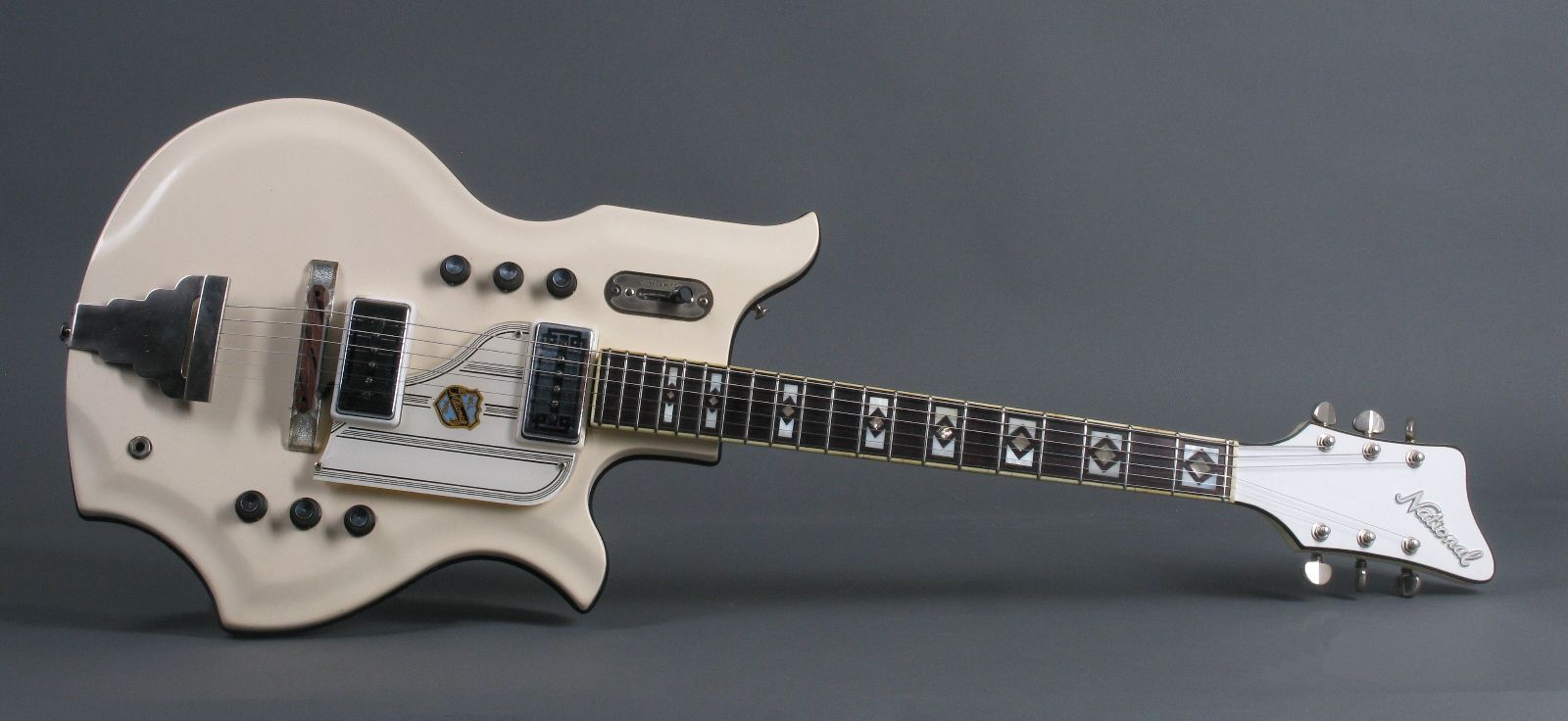
I’m not sure that the ‘Jetsons’ name for the guitar JB Hutto would subsequently adopt was an official monicker anyway. In early catalogues Jack White’s Airline was described simply as “Cherry Red Fiberglas® Dual Cutaway”, and priced at $99.95. But the first run of The Jetsons cartoon on TV from September 1962 to March ’63, prior to the debut of the model, must have prompted the tag. I guess the association was inevitable, given the influence of ‘mid-century modern’ design common to both. The Airline guitar and the Jetsons cartoon were both influenced by Atomic Age looks and Space Race styling — as well as the Googie architecture that borrowed from Californian car culture and which was such a feature of the animation style in Hanna-Barbera’s futuristic Flintstones follow-up. The new lines and styles that Valco experimented with when they landed on the idea of fibreglass construction were certainly innovative: and if there’s one thing the history of guitar making regularly throws up it’s the story of cutting edge design being way ahead of it’s time and not being taken up by musicians until many years later. Gibson abandoned their Les Paul Model in 1961, don’t forget.
Highway 61 Revisited
In any style revival there will always be the wilderness years between cutting-edge cool and retro resurrection, and apart from Rory Gallagher using one briefly in the Eighties these guitars pretty much remained in obscurity between JB Hutto’s prominent use in the Sixties and Jack White championing them again in the Noughties. Gallagher covered JB Hutto’s
'Too Much Alcohol'
sometime in the mid Seventies and his Airline Hutto was a later model (possibly a ’65) with a Fender style six-a-side headstock and a toggle pup selector rather than the earlier lever switch. After Hutto, Gallagher & White the most famous musician associated with this stylish instrument is of course Polly Harvey. The PJ Harvey JB Hutto is a white 3 pup Airline with factory Bigsby and it is the only other really high profile Jetsons Airline in popular music. Titled only as the "Professional “Vibrato” Triple Pickup model" in one Montgomery Ward mail-order book at the time for $249.95, in another catalogue it is described as “Our Finest Guitar - Fiberglas”. Eastwood have of course done a Bigsby equipped copy of the 3-pup Jetson as well. Here’s a film of Polly using her original Res-O-Glas 3 pup Hutto on
'The Last Living Rose'.
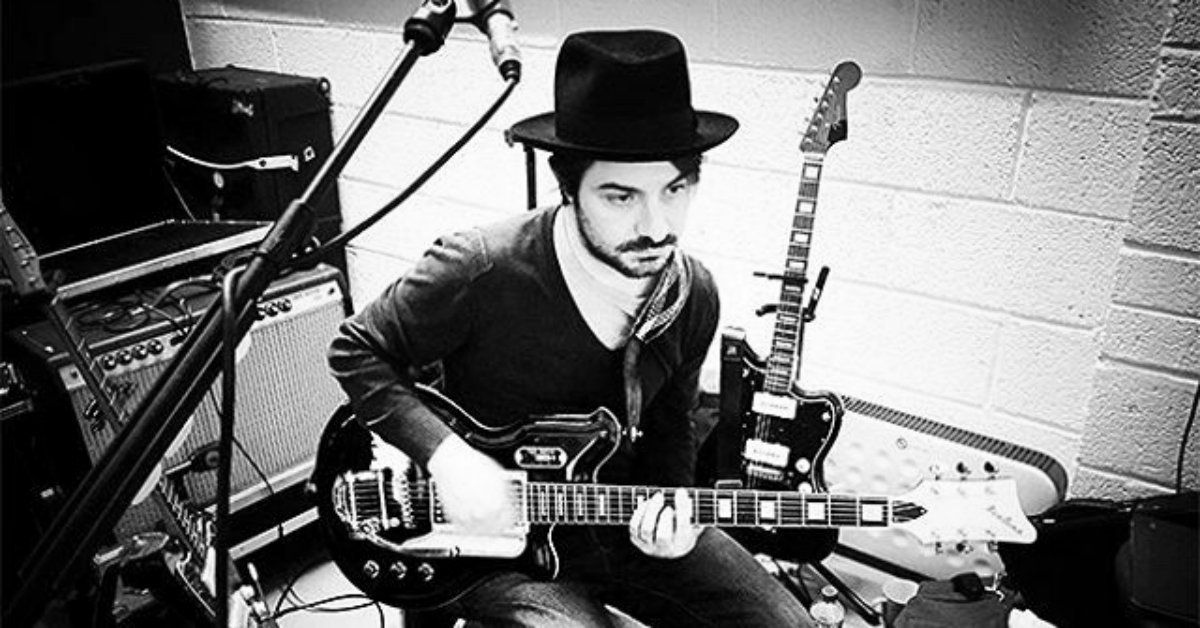
Polly didn’t play guitar much during her Hope Six Demolition Tour, apart from the early mixed media shows we did at the Royal Festival Hall in early October 2015, for the book launch of
The Hollow Of The Hand. Throughout her 2016-17 tour I did look after a black Eastwood Map DLX baritone guitar for Alessandro Stefana. With a 27” scale length and a horseshoe Bigsby tail, this Eastwood Map baritone wasn’t the most stable tuning guitar, despite stringing it with fairly heavy gauge .013 - .072 Ernie Balls. Asso usually only played the Map guitar on
Down By The Water — though it may have got rolled out for
Highway 61 Revisited occasionally during encores. I’m pretty sure there was more than one track it was used on, I don’t quite remember which though. The selector switch was always flipped forward to the neck pickup. This wasn’t a bad sound, but the bridge pup was pretty mushy for a lower register instrument and almost unusable. The high output Alnico Hot-10 humbuckers Eastwood fit to these baritones are no match for the original single coils in terms of clarity and definition. This Eastwood Map guitar has a very similar appearance to one of Robert Smith’s favourite guitars in the 1980s. Of course Wabbit was playing a Res-O-Glas National Val-Pro 88 Newport with The Cure and the Eastwood DLX, like all their copies of these cult classics, has a chambered wooden body.
Supro fast fibre
As I said, the big innovation when these guitars arrived on the scene wasn’t just the shape of the bodies, but the moulded glass fibre and resin from which they were made. The first R-O-G body was possibly made as early as 1959 with production models available from 1961, initially in the Supro name and then under the National brand. Valco had experimented with wooden bodies clad in ‘mother-of-toilet-seat’ pearlescent plastic for both Spanish and Hawaiian steel guitars under their Supro and Oahu brands. But the Res-O-Glas guitars took plastics into structural applications. Their bodies were put together from front & back fibreglass resin ‘clam shells’. Not that there was any kind of bivalve hinge: the halves were screwed together from the rear, usually with 5 fixings. The seam was disguised by a contrasting coloured, vinyl gasket which formed channels for both shell edges allowing the back to be easily replaced after accessing the innards. This ‘rubber band’, as it is still often called (it’s not rubber and it’s certainly not very elastic), wrapped around the entire edge of the two-part body. While the reissue versions of these guitars are advertised as chambered mahogany bodies, it looks like repro regents Eastwood have started to put a cosmetic ‘rubber band’ around their wooden body Airlines in recent years. Valco fibreglass body shells were supported by wooden centre struts to which the neck was bolted (and to which the pups were also mounted) and 4 or 5 foam & wood blocks spaced around the edges to which the back shell was screwed (some models had a screw into the centre strut near the tail).

You can clearly see that both Polly and Jack White play original Airlines from the ’60s — the lack of a truss rod cover on the head is an obvious identifier. Which isn’t due to heel access truss rods in the original models — these guitars had no adjustable truss. Instead the neck was constructed from a cast magnesium-aluminium alloy girder shaped much like a square lap-steel neck, which was then clad in wood and a lot of glue. And they’d been making these predominantly metal necks for quite some time. In the late ‘40s, as far as I can tell, the Valco Mfg. Co. announced their new National “Stylist” Spanish guitar neck on National brand instruments. National bought in bodies from Gibson and put their own metal core Stylist necks onto both J45 flat top and archtop bodies. The lack of a fine quality woodshop at Valco’s factory may have been another factor in their development of fibreglass bodies. The Stylist necks were billed as “An exclusive feature of NATIONAL Spanish Guitars… NO BOW - NO WARP - NO TWIST”, and as well as the Gibson quality guitars they were also bolted onto cheaper bodies sourced from another Chicago brand, the Kay Musical Instrument Company. And that's because Gibson, Kay and National shared the same parent company in Chicago Musical Instruments at this time. There was an adjustment for neck tilt at the back of the heel under a plastic plate, which was frequently misunderstood as a fixing bolt — leading to neck warping and the ruining of many Valco guitars by their owners who overtightened this bolt or adjusted it without loosening the other fasteners. When the Res-O-Glas guitars came along they still had a 24¾" scale, mahogany clad, magnesium bar called the “Kord King - The slender neck with the satin action.” These necks also had a tilt adjustment screw at the rear, and just like the later Fender 3-bolt necks, the fixing bolts need to be loosened before the tilt can be properly adjusted. Valco further described the Kord King thus: “String tension will not bow, twist, or warp this exclusive neck. It is slim, straight and comfortable. The featherweight core is of modern aircraft metal. This neck improves tone, has no heel, and is fully guaranteed.”
They’re gonna rip it off
The recent reissue models by Eastwood all have wooden necks, with headstock accessed truss rods tooled for the 4mm allen key that seems to fit the several Eastwood guitars I’ve worked on. There are other give-aways in appearance between the Valcos and the Eastwoods. Another easy identifier for original Jetsons is that they all featured a zero fret, clearly absent on the Eastwood version. The modern metal switch plate has greater contrasting colours than the Valcos. The original R-O-G Jetsons had the pickguard raised on pillar spacers (a common feature on some Valco models), where the Eastwoods are flat to the body. The Eastwoods have a T-O-M style bridge — where a carved rosewood, compensated saddle, bridge set on thumb-wheels was typical of the early Hutto Airlines and many other Valco instruments. But this was later replaced by the more austere curved metal bar common to Kay solid body instruments, and the Bigsby equipped Huttos often came with a fully adjustable bridge with what look like roller saddles.
Going back to Kurt’s Jetson Airline here in my hands: it is an Eastwood 59 2P model, Made In Korea with "vintage voiced single coils" that look like chrome cover humbuckers. This single/twin coil pup confusion is no new thing. The original Valco Vista-Tone single coils designed by Ralph Keller from the early ‘50s had wide rectangular metal covers. Gibson even had to make reference to these earlier design pickups in that famous Patent they Applied For — because while not all of those old Valco pups had visible poles, some had a single line of offset pole screws — the magnets were to the side of the lone coil, a design which Gretsch seemed to copy with their HiLoTron in 1958 (the pickup which replaced the Dynasonic: which was just Gretsch’s name for the DeArmond Fidelatone, made by Rowe Industries, another great Chicago firm). The Vista-Tone pups have a 1952 patent and appeared on Supro models as early as 1953. Some of Ralph Keller’s pups had a line of exposed pole screws down the middle, some had none on show (or one screw right in the middle), but most had six pole screws down one side. It is these visible pole screw pups, which Seth Lover’s 1957 PAF for Gibson seemed to mimic, which most often feature on the Jetson models. Height adjustment for the Vista-Tone pups was by the two outside pole screws. You can always spot that original Valcos with Vista-Tones have pup rings with no screws though them, (unlike the modern HB style pup rings on the Eastwoods). On Kurt's guitar the bridge pup has been swapped for a black bobbin Gibson style pup, presumably for a higher output. The reproduction “Vistatone” pups in the modern Supro company’s Americana range are apparently very accurate reconstructions of Keller’s killer single-coils, and some of them carry the geometric Art Deco decals of early National models.
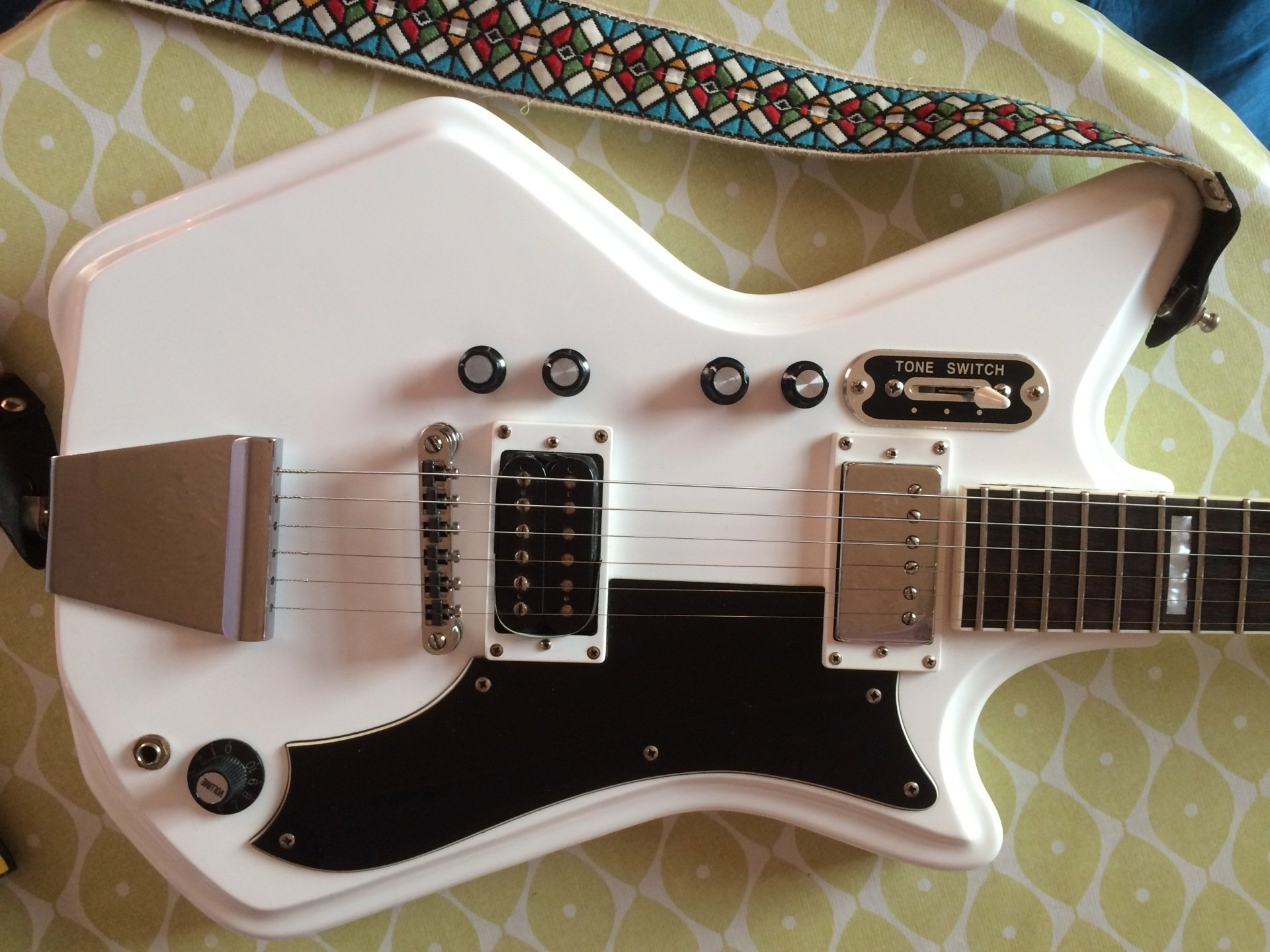
The Eastwood Jetson’s neck has a longer 25½” scale length and as mentioned earlier has that modern truss rod. Unlike newer models, Kurt’s Korean Airline does not have an Eastwood logo on the truss rod cover; and it’s four neck bolts are set in an asymmetric pattern — where on current versions they now make a more symmetrical parallelogram. Kluson style 3-on-a-plate tuners by Wilkinson replicate the originals, but have decidedly green tulip/keystone buttons — where the old ones were either the wider tulip type (sometimes called ‘butterfly keys’ in Supro advertising) or simple oval buttons in white. The higher quality National R-O-G guitars often had Grover kidney buttons in either nickel or gold plate. Looking on the Eastwood website it appears that the current white option of Kurt’s 2P guitar now has a more vintage looking tortoiseshell pickguard with white pinstripe (as opposed to the three ply B/W/B on the one I’m holding right now). A kind of German carve, front and back of the mahogany body, replicates the contouring of the original moulded fibreglass. And Kurt’s Korean Jetson was not made with the purely decorative black band around the edge of the body — currently described by Eastwood as a ‘rubber body binding’.
Eastwood Rides Again
You wouldn’t confuse this oriental Jetson for an occidental original: at 8lb this wooden Airline weighs a bit more than a Res-O-Glas guitar and balances differently. And that despite having an almost hollow body. With the pups taken out it looks to me like this Eastwood guitar body is solid wood (though I’m not saying it’s a one-piece) that has been largely routed out to more than half it’s depth. Then a thin plywood top has been glued onto the front: surely it’s ply because at only 5mm (3/16”) a solid wood sheet would be too weak. Access for the individual tone & volume pots (mounted on the bass side of the strings with small knobs in typical Valco fashion) could only be through the pup holes and I imagine the harness was installed through them in typical semi-acoustic manner. This construction is almost certainly an economic decision for speed of assembly. If I was going to use a thin wooden sheet onto a hollow routed body I would do it the Rickenbacker way and put the sheet on the back — the technique Roger Rossmeisl brought from building Rickenbackers (German carve or no) to his 1968 chambered Telecaster Thinline design. And I have always felt that the Rickenbacker Combo 600 from 1954 was an influence on the body shape of Valco instruments like the Belmont & Martinique*****. There is a long association between the various Valco, National, Dobro and Rickenbacker companies that goes back through the Dopyera brothers to electric guitar pup progenitor George Beauchamp. Indeed it is a story as litigious and as full of dispute as any family history and is an interesting part of guitar history too.
Making the Jetson-Hutto shape body out of wood is no new thing though — not all Jetsons were Res-O-Glas. I’ve seen originals with the typical Valco 2-bolt neck on wooden bodies in this shape, in both red and sunburst finishes. Both had parallel pickguards, in the Supro Town & Country style, in both single and twin pup configurations. Of course Valco started out making wooden bodies under both Supro and National name tags before they came up with the Res-O-Glas concept. I’ve always put the Res-O-Glas name down to marketing speak for the resin & glass fibre body shells, but given Valco’s National heritage in their Reso-Phonic resonator cone instruments, I think there might be more to the name. Because these instruments sound way better than a plastic guitar has any right to. And I think the neck design was as much about resonance as rigidity. Surely the fibre glass body and centre blocks have little use as sound boards and tone generators, but the metal mass of the magnesium core almost makes the neck resonate like a tuning fork. The neck bolts from the back of the heel actually go right into the magnesium girder at the neck’s core. On the R-O-G guitars there are usually 3 bolts: two for fixing and one for tilt adjustment.
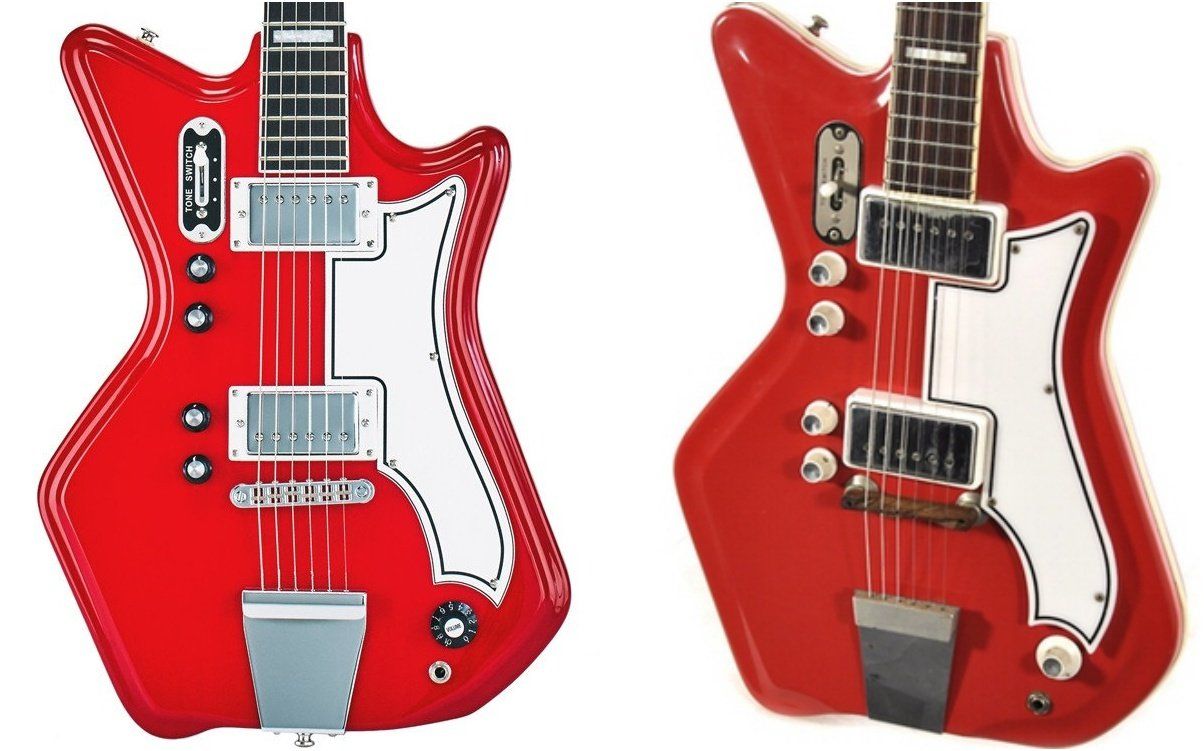
They even made a Res-O-Glas body with a Reso-Phonic cone called the Folkstar which was the Supro model S444 which also, I believe, had an Airline version. Most people who’ve played them are disparaging about the resonater cone coupled to a fibreglass body compared to say a wood bodied Dobro******. Again, Eastwood have made a “Tone Chambered Mahogany” body version of the Folkstar and added a magnetic mini humbucker at the neck in tandem with a piezo pickup in the bridge. Several original Valco models also had a pickup built into the bridge; it wasn’t however, as many people believe, a standard piezo-electric pressure sensor. Valco called it the Bridge-Tone pup and it was actually a magnetic transducer device. “The ‘Bridge-Tone’ unit is the first electronic unit to accurately reproduce the concise musical ‘string-tone’ characteristics of the arch-top guitar”, they proudly boasted: I presume they meant on a solid body guitar. The Bridge-Tone pickup was also called the Silver-Sound pup on some National models, which alternately named their under-string pups as Vista-Power units.
There is a popular misconception that these old Res-O-Glass guitars were cheap plastic crap when they came out — mass-produced from inferior materials to be cookie cutter imitations of quality wooden instruments. That’s certainly the way I remember them being perceived in the ‘80s. But while Airline models were at a budget price point compared to mid-range Supros, in 1965 the price list for R-O-G National models started at $192.50 for a single pup and went up to $450.00 for three pups & a Bigsby like Polly’s guitar. For comparison a ’65 Fender Esquire was $164.00 and a Jaguar cost $443.00. A 1965 Supro Holiday Res-O-Glas body with single pup listed for $139.50 but still cost more than a Fender Musicmaster at a $126 price point. And the materials used were certainly not cheap for the manufacturer. Valco thought they were onto a winner with fibreglass: they saw a way to streamline production and supply an improved product. Aren’t those the kind of corporate concepts that get a company really juiced?
Valco saw glass fibre construction primarily as a way to improve the durability of the finish. Because the resin held the colour it permeated right through the material and could not be scratched or worn off. And it would not crack & check due to the expansion & contraction of wood with seasonal and climatic changes. One Montgomery-Ward catalogue claimed it was an “everlasting finish”. Mind you, just a couple of lines later they also falsely claimed the PJ Harvey Hutto had an “Adjustable neck rod”. In the same catalogue Wards claimed that the PJ Hutto Professional “Vibrato” Triple Pickup model’s “Special White fiber glas body with black trim will not crack.” In an advert for their ‘New Glas Construction’ Studio 66 model Valco defined it thus: “RES-O-GLAS — Polyester resins embedded with threads of pure gleaming glass provide a new climatically immune miracle material of the space age — super durable — classically beautiful — functionally perfect.” Plus the body shells popped out of the moulds fully formed, you didn’t need to put a German carve around the top (and the back) with a router. The fibreglass clam shell bodies did not need to be carved or shaped in any way; they did not need to be primed & painted & polished: all of this saved time and labour. When Valco re-tooled the factory for large scale R-O-G production in 1961, their expectation was that it would reduce costs by up to 40%. But it was a huge miscalculation. Despite fewer production stages requiring fewer skills, the cost of investment and materials crippled them. When Valco stopped making Res-O-Glas guitars it was because the technique was too expensive with little profit margin compared to wooden bodies. For a while some late Sixties models were made as hybrids with a chambered wooden back and a ‘fibreglas’ top.
Valco’s Res-O-Glas revolution in guitar construction lasted about a decade and the Jetson/Hutto guitars were only made for about four years; it was almost a passing fad at the time. These innovative instruments quickly became unfashionable and unwanted. They languished in obscurity for decades, but these guitars have been prized by some very discerning artists over the years for their unique properties. They are instruments with Futurist finesse & anachronous antiquity all bundled up in bygone beauty. Some American commercial design from this era is called Raygun Gothic, and I think that term suits the Airline aesthetic perfectly. The Eastwood copies may have different sonic & physical properties, but they certainly capture the glamour and the grace of the original designs. And let’s face it, for many people that’s a big factor in their appeal. You can watch Kurt giving his Eastwood Jetson (she's called Missy White by the way) a good work out in this short
live set at their Bristol album launch, put together from audience phone footage. And for anyone who’s read my blog
A Sticker for Discipline — Kurt’s Jetson has RAPTOR taped across the back: upside down, of course.
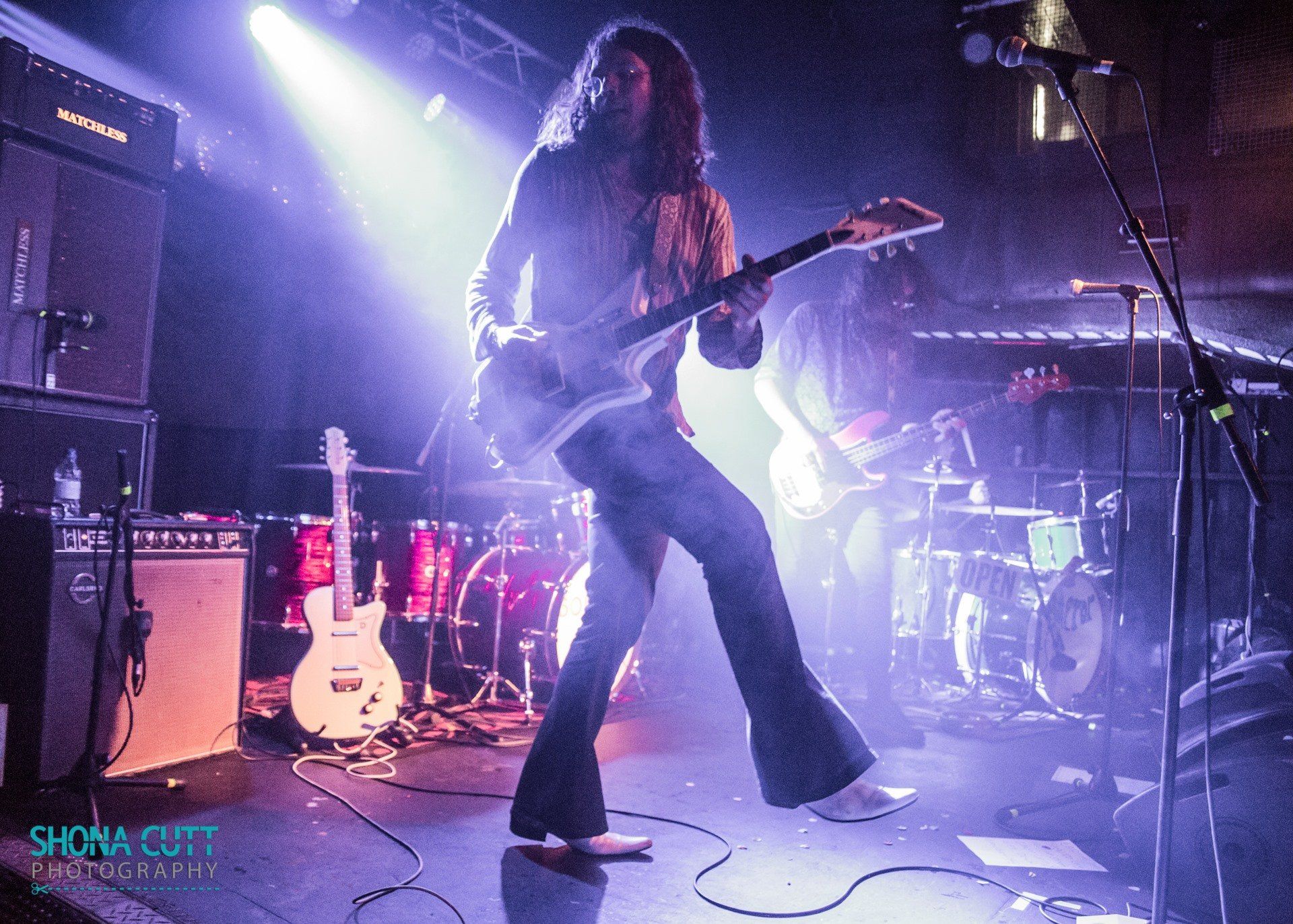
* The guitar used to record the opening track of the album was an archtop Kay K6533 with a single ‘cheese-grater’ neck pickup. The Kay was put through a Whammy to create the bassline and a Big Muff for the fuzz-sustain slide parts; before coming out of the speakers of two different amps into two different microphones. I’ll be discussing the recording of this song in greater detail in a forthcoming article.
** A variety of jobs needed to be done on Kurt’s guitar: The lever switch was too high and was bent over because it was in just the right place to get whacked by heavier strumming; the top nut slots were uneven and needed cutting to match the fingerboard radius and the nut needed to be dressed down a bit; some deep grooves had to be filed out of the first few frets and the rest of the frets levelled & crowned; and there were some gouges in the back of the headstock that needed a bit of a touch up. Kurt was kind enough to email me about it recently so I’m going to claim it as a testimonial: “I’ve been using it on some new recordings these last couple of weeks and I’m blown away with all the work you’ve done man. I can’t believe there was ever dents in some of those frets, they look brand new and it plays better than ever. Thank you so much again for looking at her.” Kurt Fletcher, January 3rd 2022.
*** Valco and Gibson built guitars such as Supro Belmonts and Epiphone Coronets (and some amp models) were also made with the Dwight brand for the Sonny Shields Music store in St. Louis, MO. Valco and Gibson were both CMI subsidiaries out of Kalamazoo, IL, at the time, as were Kay and Harmony. Incidentally, Valco bought the Kay Musical Instrument Company in 1967, just a year before Valco themselves went out of business.
**** Of course Rory was a keen student of the blues and is also famous for playing a 1954 Supro Dual Tone in the ‘80s. It took a while for the ‘cool’ people to catch on.
***** 1954 was also the year that Roger Rossmeisl moved from Gibson to Rickenbacker, before moving on to Fender in 1962.
****** I have a Dobro Hound Dog here at New Cut Studios that I picked up cheap in a pawn shop in Seattle, WA. It didn’t project as well as John Parish’s bell-metal body National, which we played it together with at the time, but I’d be interested to compare it with an R-O-G Folkstar. Again my Dobro is a modern remake, this time under Epiphone’s auspices. It’s the round neck Deluxe version with flame maple veneer body, tea strainer sound holes and that hourglass fantail string anchor that was used on so many National and Supro models.
Post script:
In the latest issue of Total Guitar White talks about the Jetson thus: “When I was in The White Stripes, Jack Oblivian [Memphis-born guitarist and garage rock cult hero] sold me that Airline for 250 bucks. I don’t think I saw another one for five years.” (Total Guitar issue 358, p.51; June 2022). It's a good article and contains a picture of an Airline that’s had some of it’s gut’s ripped out. I found a youTube clip of The Stripes from November 2005 that’s obviously filmed in Maida Vale Studio 3, and White is playing a red Jetson (on Blue Orchid) that looks to be the same one. The neck pickup and individual pots have all been removed, leaving just the bridge pup, switch and master volume. The switch plate has gone as well so maybe it’s also been disconnected or left in as a kill switch. And although that volume knob is still there by the jack, it might be bypassed anyway. Going by the pickguard and bridge, it’s probably the same guitar he bought from Oblivian.
©️Mark Vickers December 2021
